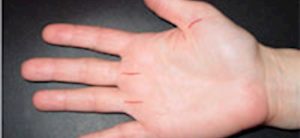Trigger Finger is a common condition which may affect any finger. It is caused by either a thickening of the tendon as it passes through a small pulley (like a tunnel) at the base of a finger, or by a narrowing of the tunnel (pulley), so the tendon gets stuck.
What is it?
Trigger Finger is a common condition which may affect any finger. It is caused by either a thickening of the tendon as it passes through a small pulley (like a tunnel) at the base of a finger, or by a narrowing of the tunnel (pulley), so the tendon gets stuck.
Symptoms experienced are of pain at the base of the finger in palm, or clicking. Eventually it may cause the finger to get stuck, with the patient unable to straighten it back out.
Is an operation needed for Trigger Finger?
Most of the time no. Some patients are given a small splint and this allows the inflammation to settle. However approximately 80% of patients respond to a single steroid (cortisone) injection. This injection is performed in the out-patient clinic. Of those 20% that failed to respond, another 80% get better after a further injection. Therefore, it is only a small proportion of patients that ever require surgery.
What does surgery involve?
The operations for Trigger Finger are usually day case procedures, which means you, can arrive and leave on the same day. It is usually performed with local anaesthetic, which means only part of your hand goes numb. The wound is approximately 1-1.5 cm. Afterwards a large dressing is applied, which you can reduce at 72 hours. There will be a small adhesive dressing over the actual wound. You need to keep the initial dressing dry.
What happens after the operation?
We will usually see you back in the clinic at around 10 days for removal of the stitches. The next appointment would be around 6 weeks. You will usually be able to drive after the stitches have been removed, IF, you have minimal pain. You must be able to perform all manoeuvres safely within the car.
More detailed information on Trigger Finger can be obtained from the NHS website: Trigger finger

